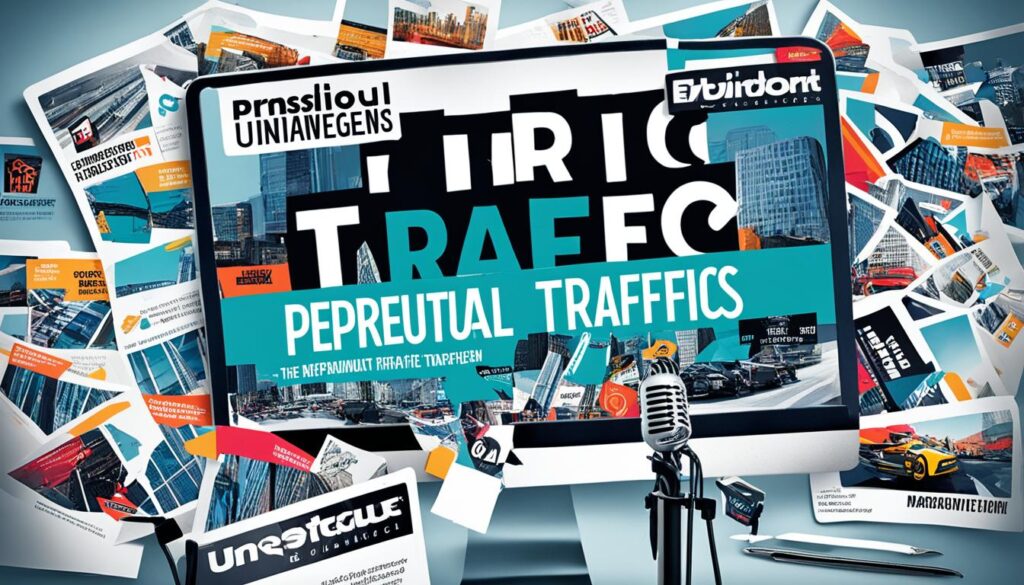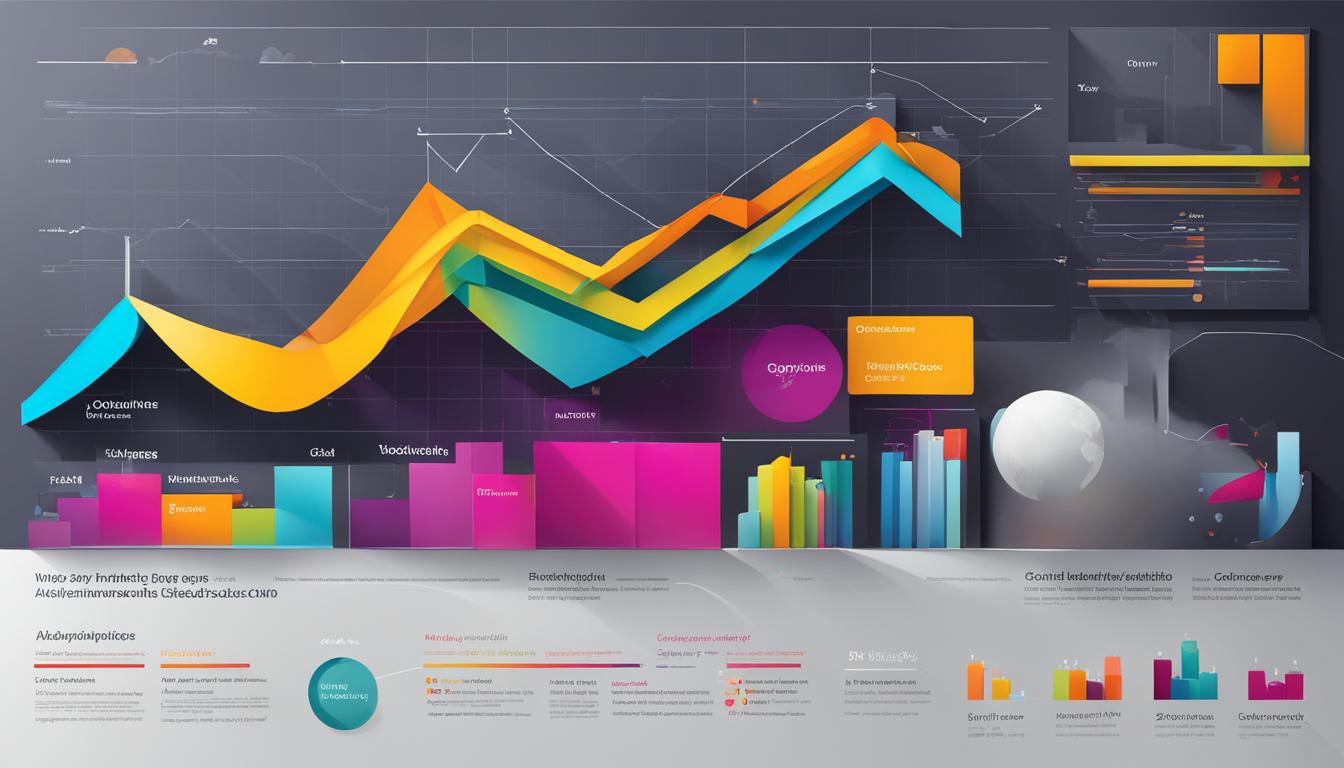Podcasting has become a popular tool for marketers to stay informed and inspired. In this article, we will explore the top marketing management podcasts that offer crucial insights, strategies, and advice for savvy marketers. Covering topics like content marketing, social media marketing, paid advertising, and more, these podcasts are a priceless resource for marketing professionals.
Key Takeaways:
- Stay informed and inspired with top marketing management podcasts.
- Podcasts offer valuable insights, strategies, and advice for marketers.
- Cover a range of topics including content marketing, social media marketing, and paid advertising.
- Podcasts are a valuable resource for marketing professionals.
- Enhance your marketing skills and strategies by tuning in to these podcasts.
This Old Marketing hosted by Joe Pulizzi and Robert Rose
This Old Marketing, hosted by two content marketing pioneers Joe Pulizzi and Robert Rose, is a must-listen podcast for marketers looking to stay ahead of the curve. With their reactive analysis of real-time industry trends, Joe and Robert provide valuable insights and predictions for the future of marketing.
Delving into the vast realm of content marketing, This Old Marketing covers a wide range of topics to help marketers sharpen their skills. From exploring the latest marketing trends to dissecting effective strategies, this podcast offers practical tips and techniques for enhancing content marketing efforts.
One of the key areas This Old Marketing focuses on is the distinction between influencers and content creators. With their expertise and experience, Joe and Robert offer unique perspectives on how to leverage the power of both influencers and content creators to drive marketing success.
This Old Marketing stands out as a valuable resource for marketers seeking to stay up-to-date on the latest content marketing tactics and techniques.
Key Takeaways from This Old Marketing
| Topics Covered | Insights Offered |
|---|---|
| Content marketing trends | Discover the latest trends shaping the content marketing landscape and learn how to adapt to them. |
| Effective content marketing strategies | Gain valuable insights into developing and implementing successful content marketing strategies for your brand. |
| Difference between influencers and content creators | Understand the unique roles and benefits of both influencers and content creators in your marketing campaigns. |
Whether you are an experienced marketer or just starting out, tuning in to This Old Marketing will provide you with actionable marketing management tips to propel your success in the ever-evolving world of content marketing.
Unthinkable hosted by Jay Acunzo
Unthinkable is a captivating marketing podcast that delves into the art of storytelling in the digital age. In this podcast, I invite you to join us as we explore how to break through the noise and create resonant messages that captivate your audience. Hosted by the talented Jay Acunzo, this podcast features insightful interviews with CEOs, marketers, and creators who share their innovative approaches to storytelling.
If you’re looking to enhance your storytelling skills and gain valuable insights into crafting compelling marketing narratives, Unthinkable is the perfect resource for you. Through authentic conversations and practical advice, this podcast will empower you to think creatively and develop effective marketing strategies.
“Unthinkable explores the art of storytelling in the digital age, helping marketers break through the noise and create resonant messages.”
Gain Valuable Marketing Management Strategies
Unthinkable goes beyond the surface-level marketing strategies and dives deep into the core of storytelling. Through real-life examples and thought-provoking discussions, Jay Acunzo and his guests uncover valuable marketing management strategies that can elevate your brand’s narrative.
- Learn how to captivate your audience through compelling storytelling techniques.
- Discover innovative approaches to engage customers in today’s crowded digital landscape.
- Gain insights into crafting authentic and resonant marketing messages.
- Explore strategies to break through the noise and make a lasting impact on your audience.
Expert Advice for Marketing Managers
As a marketing manager, staying ahead of the curve is crucial to your success. The Unthinkable podcast provides valuable advice from industry experts that can help you refine your marketing management skills and achieve your goals.
- Learn from CEOs, marketers, and creators who have successfully implemented innovative storytelling techniques.
- Discover how to create a brand narrative that resonates with your target audience.
- Get practical tips on how to navigate the challenges of the digital landscape and stand out from the competition.
- Expand your knowledge of marketing management strategies and gain a fresh perspective on marketing trends.
To listen to Unthinkable and gain valuable marketing management strategies and advice, visit their website or search for the podcast on your preferred platform.

Everyone Hates Marketers hosted by Louis Grenier
In the world of marketing, it’s important to stand out and think differently. That’s exactly what you’ll find in the podcast Everyone Hates Marketers hosted by Louis Grenier. With a unique and edgy approach, this podcast provides valuable insights into marketing strategies, industry trends, and unconventional approaches to marketing. Louis Grenier inspires listeners to challenge the status quo and embrace fresh perspectives and outside-the-box ideas.
Unlike traditional marketing podcasts, Everyone Hates Marketers takes a candid and humorous approach to discussing marketing topics. It’s a refreshing change of pace that will keep you engaged and entertained while learning valuable marketing management insights.
“Instead of following the crowd, we encourage marketers to embrace their individuality and think outside the box. Our goal is to inspire and empower marketers to make a real impact while avoiding the cookie-cutter approaches that everyone hates.”
Whether you’re a seasoned marketer or just starting out, this podcast is a valuable resource for marketing management resources and insights. Here are some key reasons why you should consider tuning into Everyone Hates Marketers:
- Gain fresh perspectives on marketing strategies
- Stay up-to-date on industry trends
- Learn unconventional approaches to marketing
- Discover marketing insights from industry experts
So, if you’re tired of the same old marketing podcasts and are looking for something different, Everyone Hates Marketers is a must-listen. It’s time to break free from the conventional and embrace a new way of thinking about marketing.
Key Takeaways from Everyone Hates Marketers
| Key Takeaways | Benefits |
|---|---|
| Embrace unconventional marketing strategies | Stand out from the competition |
| Learn from candid and humorous conversations | Stay engaged and entertained while learning |
| Stay up-to-date on industry trends | Be a step ahead of the competition |
| Gain fresh perspectives on marketing | Generate innovative ideas for your marketing campaigns |
To tune in to Everyone Hates Marketers, visit their website or listen on your favorite podcast platform. It’s time to break free from the ordinary and start thinking differently about marketing.

The LinkedIn Ads Show hosted by AJ Wilcox
The LinkedIn Ads Show is a podcast that delves deep into the world of LinkedIn advertising. Hosted by AJ Wilcox, this podcast provides invaluable insights and analysis for marketers looking to harness the power of LinkedIn in their digital marketing strategies.

In each episode, AJ Wilcox shares his expertise as a LinkedIn Ads expert and provides expert analysis on various topics related to LinkedIn advertising. From community hacks to interviews with product specialists, this podcast offers a wealth of knowledge and actionable tips for marketers.
Expert analysis and insider tips
- Discover community hacks to optimize your LinkedIn ad campaigns
- Gain insights from interviews with LinkedIn product specialists
- Stay up-to-date with the latest features and updates on the LinkedIn advertising platform
The LinkedIn Ads Show is a valuable resource for marketers looking to stay ahead of the curve in the digital marketing landscape. By leveraging the expertise and insights shared on this podcast, marketers can unlock the full potential of LinkedIn advertising and achieve their marketing goals.
The Shakeup hosted by Alexis Gay and Brianne Kimmel
The Shakeup is a thought-provoking podcast that pushes the boundaries of business and marketing. Hosted by Alexis Gay and Brianne Kimmel, this podcast challenges the status quo and invites listeners to explore innovative approaches to marketing and business management. Through engaging discussions with leaders, change-makers, and business model busters, The Shakeup offers valuable insights into groundbreaking marketing strategies and unconventional thinking.
The Shakeup isn’t afraid to ask tough questions and break down traditional norms. By defying conventions and sharing unique perspectives, this podcast inspires marketers to think outside the box and embrace new ideas. Whether you’re a seasoned marketing professional or a business owner looking to shake things up, The Shakeup provides thought-provoking insights that can drive your marketing strategies to new heights.
| Potential Topics Discussed: | Key Takeaways: |
|---|---|
| Disruptive marketing strategies | Innovative ways to stand out in saturated markets |
| Breaking free from traditional marketing approaches | Challenging the status quo and pushing boundaries |
| Unconventional business models | Creative approaches to business management |
| Leadership lessons from successful disruptors | How to carve your own path and drive change |

Experience The Shakeup and prepare to challenge your preconceptions, shatter conventions, and unlock your full marketing potential. Tune in to this inspiring podcast to gain fresh insights, actionable ideas, and a fresh perspective on business and marketing management.
Perpetual Traffic hosted by Kasim Aslam and Ralph Burns
Perpetual Traffic is a highly informative and dynamic marketing podcast that delves into the realm of paid traffic. As the digital advertising landscape rapidly evolves, staying up to date on the best practices and techniques is essential for marketers aiming to optimize their campaigns. Kasim Aslam and Ralph Burns, the hosts of Perpetual Traffic, bring their expertise and insights to educate listeners on everything from search to social advertising.
With a focus on budgeting, ROI measurement, and brand awareness, this podcast covers a wide range of topics that can help marketers navigate the complexities of paid traffic. The knowledge shared by Aslam and Burns empowers marketers to develop effective strategies and achieve their marketing goals.
Discover the latest trends and tactics in digital advertising by tuning into Perpetual Traffic. Let us guide you through the world of paid traffic and equip you with the best practices and techniques to enhance your marketing campaigns.

Why Perpetual Traffic is Essential for Marketers
- Stay updated on the ever-changing landscape of digital advertising.
- Learn best practices for budgeting and maximizing ROI.
- Master the art of brand awareness through paid traffic.
- Obtain actionable insights from industry experts Kasim Aslam and Ralph Burns.
| Benefits of Perpetual Traffic | Takeaways |
|---|---|
| Informed decision-making | Gain valuable insights to make data-driven decisions in your marketing campaigns. |
| Optimized advertising campaigns | Learn best practices and techniques to enhance your paid traffic strategies. |
| Industry expertise | Tap into the knowledge and experience of marketing experts Kasim Aslam and Ralph Burns. |
| Enhanced brand awareness | Discover effective strategies to amplify your brand’s presence through paid advertising. |
“Perpetual Traffic provides the latest insights and best practices in paid traffic, empowering marketers to optimize their campaigns and drive meaningful results.” – Kasim Aslam
With Perpetual Traffic, you’ll gain a competitive edge in the rapidly evolving world of digital advertising. Aslam and Burns will guide you through the intricacies of paid traffic, ensuring your marketing efforts are effective and impactful.
The Marketing Analytics Show hosted by Anna Shutko
The Marketing Analytics Show is a valuable resource for marketers looking to harness the power of data-driven decision-making. Hosted by Anna Shutko, this podcast is dedicated to the world of marketing analytics, providing valuable insights and strategies for marketing managers.
Key Topics Covered:
- Budgeting for marketing campaigns
- Measuring ROI (Return on Investment)
- Building brand awareness through analytics
Anna Shutko interviews leaders and innovators in the analytics space, offering practical advice and expert guidance for leveraging data in marketing strategies. By tuning into The Marketing Analytics Show, marketers can gain valuable insights and stay ahead of the curve in today’s data-driven marketing landscape.
“Data-driven decision-making is crucial in today’s marketing landscape. The Marketing Analytics Show provides marketers with the knowledge and insights they need to make informed decisions and create effective marketing strategies.”
Guest Speaker: Anna Shutko
| Experience | Expertise | Affiliation |
|---|---|---|
| Anaconda | Data Science | Chief Data Scientist |
| IBM | Analytics | Data Analytics Consultant |
| Marketing Analytics Show | Marketing Analytics | Host |
Whether you’re a marketing manager looking for resources or seeking valuable insights into marketing analytics, The Marketing Analytics Show is a must-listen podcast that will help you make data-driven decisions and stay ahead in your marketing efforts.
Marketing Over Coffee hosted by Christopher Penn and John Wall
Marketing Over Coffee is a podcast that takes a casual conversational approach to exploring a wide range of marketing topics. As hosts, Christopher Penn and John Wall offer a unique perspective, covering both time-tested and innovative marketing techniques. They provide valuable tips and tricks that can only be found in casual conversation, making each episode an engaging and informative experience.
Whether you’re interested in paid advertising, email list-building, SEO, or other marketing strategies, Marketing Over Coffee has got you covered. The hosts dive deep into various marketing techniques, shedding light on their effectiveness and how they can be applied to real-world scenarios. By listening to this podcast, marketers can gain actionable insights that can be implemented into their own marketing campaigns and strategies.
Key Features of Marketing Over Coffee:
- Informal and conversational approach to discussing marketing topics
- Coverage of both traditional and cutting-edge marketing techniques
- Valuable tips and tricks that can only be found in casual conversation
Marketing Over Coffee is a valuable resource for marketers looking for actionable insights and fresh perspectives. The casual format of the podcast makes it easy to follow along and absorb the wealth of knowledge shared by Christopher Penn and John Wall. Tune in each week to stay up-to-date with the latest marketing trends and techniques.
Twenty Thousand Hertz hosted by Dallas Taylor
Twenty Thousand Hertz is a unique podcast that delves into the power of audio content. Hosted by Dallas Taylor, this podcast offers fascinating insights into the stories behind the world’s most recognizable and interesting sounds. By exploring the role of sound in marketing, Twenty Thousand Hertz presents a fresh perspective on how audio can be leveraged to enhance branding and content marketing strategies.
In each episode, Dallas Taylor dives deep into the science, psychology, and cultural impact of various sounds, uncovering the hidden stories behind them. Whether it’s the iconic Intel jingle or the sound of the MGM lion’s roar, this podcast reveals the meticulous work and creativity that goes into creating memorable auditory experiences.
By listening to Twenty Thousand Hertz, marketers can gain a deeper understanding of how audio can evoke emotions, capture attention, and establish strong brand associations. From sonic branding to immersive audio experiences, this podcast provides valuable insights and inspiration for incorporating sound into marketing strategies.
Why Sound Matters in Marketing
Sound plays a vital role in shaping our perception and memory. Research has shown that auditory stimuli can have a powerful impact on our emotions, behavior, and purchasing decisions. Incorporating sound into marketing campaigns can help create a multisensory experience that resonates with customers and leaves a lasting impression.
By leveraging audio content, marketers can tap into the power of storytelling in a unique and engaging way. Sound can transport listeners to different times, places, and emotions, establishing a deep connection and fostering brand loyalty.
“The sounds we hear have the ability to affect us emotionally, enhance our recall, and influence our decision-making.”
Source: Harvard Business Review
The Role of Audio in Content Marketing
Audio content is an increasingly popular format in the world of content marketing. Whether through podcasts, voice-overs, or branded audio experiences, businesses are recognizing the value of delivering their messages through sound.
Podcasts, in particular, are an effective medium for reaching and engaging with target audiences. They provide a convenient way for listeners to consume valuable information, industry insights, and expert advice. Moreover, podcasts allow marketers to showcase their expertise, establish thought leadership, and build trust with their audience.
“Audio content helps marketers connect with their audience on a deeper level and build authentic relationships.”
Source: Content Marketing Institute
Podcast Recommendation: Twenty Thousand Hertz
For marketers seeking inspiration and knowledge about the power of audio content, Twenty Thousand Hertz is a must-listen podcast. Host Dallas Taylor’s engaging storytelling and in-depth exploration of sound provide valuable insights into how marketers can leverage audio to captivate audiences and create memorable brand experiences.
Each episode of Twenty Thousand Hertz takes listeners on a journey through the fascinating world of audio, revealing the artistry, science, and marketing strategies behind various sounds. From the iconic sound effects in movies to the sonic branding of major companies, this podcast uncovers the secrets of successful auditory experiences.
- Gain insights into the psychology and impact of sound in marketing
- Discover innovative ways to incorporate audio into your content marketing strategies
- Learn from compelling stories and case studies about the power of sound
- Stay up-to-date with the latest trends and developments in audio branding
Start listening to Twenty Thousand Hertz and unlock the potential of audio in your marketing efforts.
The Social Media Marketing Podcast hosted by Michael Stelzner
The Social Media Marketing Podcast is a valuable resource for marketers seeking the latest trends and strategies in social media marketing. Hosted by Michael Stelzner, this podcast covers a wide range of topics related to digital marketing, offering practical tips and insights to enhance your marketing efforts.
With a focus on social media platforms and their impact on business, The Social Media Marketing Podcast equips marketers with the knowledge and tools to build an effective online presence. Whether you’re a beginner or an experienced marketer, you’ll find valuable information and actionable advice to stay ahead of the game.
Stay Updated on Social Media Trends
Stay tuned to The Social Media Marketing Podcast for the latest trends and developments in social media marketing. Michael Stelzner brings you insights into emerging platforms, algorithm changes, and industry updates, ensuring that you’re always up-to-date with the ever-evolving world of social media.
| Key Topics Covered: | ||
|---|---|---|
| 1. The Metaverse | ||
| 2. Social Tokens | ||
| 3. Impact of Cryptocurrency on Business |
Unlock Marketing Management Tips
The Social Media Marketing Podcast provides valuable tips and strategies to enhance your marketing management skills. Learn from industry experts and successful marketers as they share their experiences and provide insights that can help you improve your digital marketing campaigns.
“The Social Media Marketing Podcast has been a game-changer for me. The tips and strategies I’ve learned have helped me level up my social media marketing efforts.” – John Smith
From audience targeting and engagement strategies to content creation and measurement, The Social Media Marketing Podcast covers a wide range of topics to help you navigate the dynamic world of digital marketing with confidence.
Takeaways and Actionable Insights
Every episode of The Social Media Marketing Podcast offers valuable takeaways and actionable insights that you can implement right away. From practical tips to innovative strategies, each episode is designed to help you optimize your social media marketing efforts and achieve better results.
- Discover the latest social media trends
- Learn from industry experts and successful marketers
- Get practical tips and actionable insights
Don’t miss out on the valuable information and inspiration provided by The Social Media Marketing Podcast. Tune in today and take your social media marketing to new heights!
Conclusion
In conclusion, these top marketing management podcasts offer a wealth of knowledge and insights for marketers at all levels. Whether you’re looking for strategies, tips, or inspiration, these podcasts cover a wide range of topics and provide valuable insights from industry experts.
By tuning in to these podcasts, marketers can stay informed, inspired, and continuously improve their marketing skills and strategies. The hosts of these podcasts are experts in their respective fields and share their expertise and real-life experiences, making the content relatable and actionable.
Whether you’re a seasoned professional or just starting out in the marketing world, these podcasts offer a valuable resource to enhance your knowledge and stay up-to-date with the latest trends and best practices. So plug in your headphones and start listening to these top marketing management podcasts today to take your marketing game to the next level!
FAQ
What are the top marketing management podcasts for professionals?
The top marketing management podcasts for professionals include “This Old Marketing,” “Unthinkable,” “Everyone Hates Marketers,” “The LinkedIn Ads Show,” “The Shakeup,” “Perpetual Traffic,” “The Marketing Analytics Show,” “Marketing Over Coffee,” “Twenty Thousand Hertz,” and “The Social Media Marketing Podcast.”
Which podcast covers content marketing strategies?
Joe Pulizzi and Robert Rose host “This Old Marketing,” a podcast that provides valuable insights and predictions for the future of marketing, covering a wide range of topics related to content marketing.
Where can I gain insights into innovative storytelling approaches?
“Unthinkable” hosted by Jay Acunzo explores innovative approaches to storytelling in the digital age and features interviews with CEOs, marketers, and creators.
Which podcast offers unconventional marketing perspectives?
“Everyone Hates Marketers” takes a unique and edgy approach to marketing, inspiring listeners to think differently in their marketing efforts and providing insights into industry trends and strategies.
How can I learn about LinkedIn advertising?
“The LinkedIn Ads Show” hosted by AJ Wilcox provides expert analysis, community hacks, and interviews with product specialists, specifically focusing on the world of LinkedIn advertising.
Where can I find interviews with leaders who have shattered conventions?
“The Shakeup” hosted by Alexis Gay and Brianne Kimmel interviews leaders, change-makers, and business model busters, offering insights into innovative marketing strategies and approaches.
Which podcast covers paid traffic strategies?
“Perpetual Traffic” hosted by Kasim Aslam and Ralph Burns covers all things related to paid traffic, including search and social advertising, budgeting, ROI measurement, and brand awareness.
Where can I learn about marketing analytics and data-driven decision-making?
“The Marketing Analytics Show” hosted by Anna Shutko is dedicated to the world of marketing analytics and features interviews with leaders and innovators in the analytics space.
Which podcast provides a conversational approach to marketing topics?
“Marketing Over Coffee” hosted by Christopher Penn and John Wall takes a casual conversational approach to discussing a wide range of marketing topics, offering tips and tricks not typically found in formal settings.
How can I explore the role of audio in marketing?
“Twenty Thousand Hertz” hosted by Dallas Taylor explores the power of audio content and offers insights into the use of audio in branding and content marketing.
Where can I stay informed about the latest social media trends and strategies?
“The Social Media Marketing Podcast” hosted by Michael Stelzner covers a wide range of topics related to social media marketing, including the metaverse, social tokens, and the impact of cryptocurrency on business.










